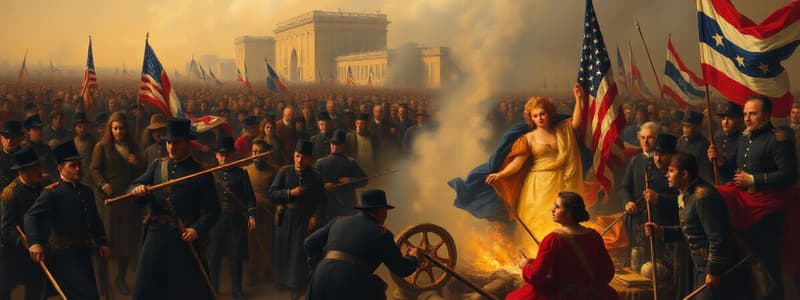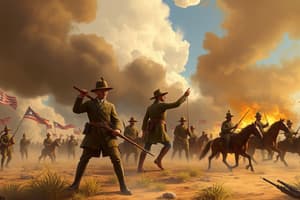Podcast
Questions and Answers
What was the significance of the Battle of Antietam?
What was the significance of the Battle of Antietam?
- It marked the start of the Civil War.
- It was the bloodiest single-day battle in U.S. history. (correct)
- It resulted in the first strategic Confederate victory.
- It ended General Robert E. Lee's career.
What effect did the Emancipation Proclamation have on the Civil War's goals?
What effect did the Emancipation Proclamation have on the Civil War's goals?
- It had no impact on the war's strategy.
- It allowed the South to continue slavery.
- It shifted the focus to include the abolition of slavery. (correct)
- It weakened the Union's resolve.
Which battle is considered a turning point in the Civil War due to ending Lee's invasion of the North?
Which battle is considered a turning point in the Civil War due to ending Lee's invasion of the North?
- Shiloh
- Antietam
- Vicksburg
- Gettysburg (correct)
What strategic advantage did the Union gain by capturing Vicksburg?
What strategic advantage did the Union gain by capturing Vicksburg?
Which advantage did the Confederacy hold over the Union?
Which advantage did the Confederacy hold over the Union?
What was a disadvantage faced by Union troops during the Civil War?
What was a disadvantage faced by Union troops during the Civil War?
How did foreign intervention play a role in the Union's strategy following the Emancipation Proclamation?
How did foreign intervention play a role in the Union's strategy following the Emancipation Proclamation?
What was a challenge the Union faced in terms of leadership at the beginning of the Civil War?
What was a challenge the Union faced in terms of leadership at the beginning of the Civil War?
What was a significant disadvantage for the Confederacy during the Civil War?
What was a significant disadvantage for the Confederacy during the Civil War?
Why were border states crucial to the Union's strategy?
Why were border states crucial to the Union's strategy?
What controversial action did Lincoln take to maintain national security during the Civil War?
What controversial action did Lincoln take to maintain national security during the Civil War?
What sparked the New York City Draft Riots in 1863?
What sparked the New York City Draft Riots in 1863?
What was one major consequence of the Civil War's massive loss of life?
What was one major consequence of the Civil War's massive loss of life?
What did the 14th Amendment guarantee?
What did the 14th Amendment guarantee?
What role did the Freedmen's Bureau play during Reconstruction?
What role did the Freedmen's Bureau play during Reconstruction?
How did Presidential Reconstruction differ from Congressional Reconstruction?
How did Presidential Reconstruction differ from Congressional Reconstruction?
What was a short-term effect of Reconstruction on African Americans?
What was a short-term effect of Reconstruction on African Americans?
What was a long-term challenge for African Americans after Reconstruction?
What was a long-term challenge for African Americans after Reconstruction?
Which Civil Rights Act was aimed at preventing racial discrimination in public accommodations?
Which Civil Rights Act was aimed at preventing racial discrimination in public accommodations?
What were Black Codes primarily designed to accomplish?
What were Black Codes primarily designed to accomplish?
What was the outcome of the Compromise of 1877?
What was the outcome of the Compromise of 1877?
Flashcards
Battle of Antietam
Battle of Antietam
The bloodiest single-day battle in US history, with around 22,000 casualties. Though tactically a stalemate, it was a strategic Union victory that gave President Lincoln the confidence to issue the Emancipation Proclamation.
Emancipation Proclamation
Emancipation Proclamation
A presidential proclamation issued by Abraham Lincoln on January 1, 1863, freeing enslaved people in Confederate states. It shifted the war's goal to include abolition and made foreign intervention less likely.
Battle of Gettysburg
Battle of Gettysburg
A major turning point in the Civil War fought in July 1863. The Union victory marked the end of General Robert E. Lee's invasion of the North and shifted the war's momentum in favor of the Union.
Siege of Vicksburg
Siege of Vicksburg
Signup and view all the flashcards
Union Advantages in the Civil War
Union Advantages in the Civil War
Signup and view all the flashcards
Confederate Advantages in the Civil War
Confederate Advantages in the Civil War
Signup and view all the flashcards
Union Disadvantages in the Civil War
Union Disadvantages in the Civil War
Signup and view all the flashcards
Confederate Disadvantages in the Civil War
Confederate Disadvantages in the Civil War
Signup and view all the flashcards
Confederate Population Disadvantage
Confederate Population Disadvantage
Signup and view all the flashcards
Confederate Economic Disadvantage
Confederate Economic Disadvantage
Signup and view all the flashcards
Lack of International Support for the Confederacy
Lack of International Support for the Confederacy
Signup and view all the flashcards
Importance of Border States
Importance of Border States
Signup and view all the flashcards
Lincoln's Suspension of Habeas Corpus
Lincoln's Suspension of Habeas Corpus
Signup and view all the flashcards
1863 New York Draft Riots
1863 New York Draft Riots
Signup and view all the flashcards
Impact of Death and Loss in the Civil War
Impact of Death and Loss in the Civil War
Signup and view all the flashcards
13th Amendment
13th Amendment
Signup and view all the flashcards
14th Amendment
14th Amendment
Signup and view all the flashcards
15th Amendment
15th Amendment
Signup and view all the flashcards
Freedmen's Bureau
Freedmen's Bureau
Signup and view all the flashcards
Presidential Reconstruction
Presidential Reconstruction
Signup and view all the flashcards
Congressional (Radical) Reconstruction
Congressional (Radical) Reconstruction
Signup and view all the flashcards
Short-Term Effects of Reconstruction
Short-Term Effects of Reconstruction
Signup and view all the flashcards
Long-Term Effects of Reconstruction
Long-Term Effects of Reconstruction
Signup and view all the flashcards
Study Notes
The Civil War and Reconstruction: Key Events and Impacts
- Antietam (1862): Bloodiest single-day battle in US history (approx. 22,000 casualties). A strategic Union victory, leading to the Preliminary Emancipation Proclamation.
- Emancipation Proclamation (1863): Freed enslaved people in Confederate states, redefined the war's aim, and lessened the chance of foreign intervention.
- Gettysburg (1863): Crucial turning point, ending Lee's invasion of the North, shifting war momentum to the Union. High Confederate casualties were decisive.
- Vicksburg (1863): Union capture ensured control of the Mississippi River, splitting the Confederacy and disrupting its logistics. Grant's victory was key to this.
- Union Advantages: Larger population; stronger industry; more and better railroads; naval superiority.
- Union Disadvantages: Fighting on unfamiliar territory; initial struggles finding capable generals.
- Confederacy Advantages: Defensive war on home soil; skilled military leadership (e.g., Lee, Jackson); strong motivation for independence.
- Confederacy Disadvantages: Smaller population; weaker economy; lack of international support.
- Border States: Crucial to Union success due to strategic locations. Maryland protected Washington D.C.; Kentucky and Missouri controlled vital transportation routes.
- Suspension of Habeas Corpus: Lincoln suspended this right claiming it necessary for national security to arrest Confederate sympathizers.
- 1863 Draft Riots: New York City riots, opposed to the draft and fighting for abolition, mainly by working-class Irish immigrants.
- Civil War Casualties: Estimated 620,000-750,000 deaths; millions more wounded.
- Reconstruction Amendments: 13th (abolished slavery); 14th (granted citizenship and equal protection); 15th (African American men's right to vote).
- Freedmen's Bureau: Established to aid formerly enslaved people and poor whites through food, medical care, housing, and education. Their schools were critical to expanding literacy in the South.
- Presidential vs. Congressional Reconstruction: Presidential (Johnson): lenient; Congressional (Radical Republicans): harsher terms, military occupation, 14th and 15th Amendments, and Reconstruction Acts (divided the South into military districts).
- Short-Term Reconstruction Impacts: African American political gains; white Southern resistance; violence and intimidation from groups like the KKK.
- Long-Term Reconstruction Impacts: Economic and social challenges (sharecropping, tenant farming); return of white-dominated governments; Jim Crow laws.
- Civil Rights Act of 1866: All people born in the US (except Native Americans) were citizens; guaranteed some civil rights.
- Civil Rights Act of 1875: Prohibited racial discrimination in public places but poorly enforced and later deemed unconstitutional.
- Resistance to Reconstruction: Black Codes restricted African American freedoms; the KKK used violence and intimidation. Poll taxes and literacy tests disfranchised.
- Compromise of 1877: Federal troops removed from the South; marked the end of Reconstruction. This led to Redeemer governments, which were Southern Democratic governments.
Studying That Suits You
Use AI to generate personalized quizzes and flashcards to suit your learning preferences.




